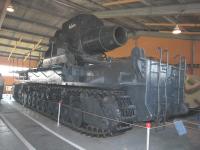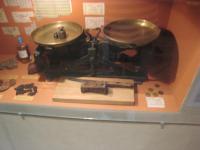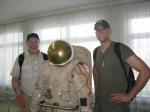Every night, after returning home from Russia, powerful dreams are still holding me in that country. In addition to seeing what contemporary Russia is like after the breakup of the old Soviet Union, I learned and saw a lot about what happened during World War II in three cities: Moscow, Volgograd and St. Petersburg. It made a deep impression.
I.Getting There
There’s no direct flight between Manila and Moscow. The most convenient and inexpensive route means flying first to Hong Kong and then changing to Aeroflot which goes non-stop from there to Moscow in about 10 hours. Aeroflot prices, I discovered happily, are very low: About $695 round trip Hong Kong-Moscow. The airline uses modern Airbus 330 aircraft and one’s experience on board is about the same as any other airline. There are the same slightly annoying announcements about seat belts and tray tables. In this case, they are in Russian, English and Chinese. One immediate difference is the uniform of the flight attendants – a nicely tailored one, but in a very bright reddish orange color that would be better suited for Halloween crepe paper. Other passengers agreed with my assessment.
While in the boarding phase, the plane’s cabin sound system played Chopin, for me a very nice change from the nondescript pop fare that other airlines use. All of Aeroflot’s aircraft have names of famous people on them. My Airbus was called E. Svetlanov, named for a well-known Russian orchestra conductor. “A nice idea”, I thought.
Service on board was good and I continued to enjoy the classical music experience listening through headphones to Boris Berezovsky’s remarkable performance of one of Liszt’s piano compositions. Later, while in Russia, I mentioned this to someone who told me he’d never heard of the pianist but did know that one of the most notorious (now exiled and threatened with arrest) post-Soviet Russian oligarchs has the same name.
Dinner was delicious – a beef curry that pulled no punches when it came to spiciness and flavor. Aeroflot wasn’t serving least common denominator food.
The other memory of that flight concerns two Russian passengers who sat facing each other. The woman had moved from her assigned seat and was sitting in a flight attendant jump seat facing backwards and talking with a man in a passenger seat facing her. They were drinking alcohol he had brought on board (it’s politically correct on Aeroflot!). They were acquaintances, but as the flight progressed the alcohol flowed and their conversation became increasingly animated. They leaned forward toward each other intensely, their faces becoming very close. It was fascinating behavior and I watched them with interest, never having seen anything like it on an airplane. They must have chatted for two or three hours and their obvious deep rapport and engagement with each other made a lasting impression on me.
II.The Tour – An outline
The tour company that organized the trip promotes “Adventure Travel” in modern Russia. It offers visitors such attractions as going for a ride on a Mig-29 fighter plane, or visiting the Baikonur space center. But my tour, focused on the 65th Anniversary of Victory in Europe, was not an adventure in that sense. A Mig-29 can take someone to the upper reaches of the atmosphere at supersonic speeds. There’s no way to compare that thrilling experience with going back in time and entering into the world of the Second World War, a historical tragedy and nightmare. It wasn’t a fun ride.
On June 22, 1941, Hitler’s armies, fresh from resounding victories in many European countries, invaded the Soviet Union. Millions of highly trained, motivated and well-supplied soldiers, together with thousands of armored vehicles poured across the border, as the Luftwaffe launched simultaneous bombing attacks on cities. The aggression combined different kinds of strike forces in ruthless attacks against the Red Army and against civilians. The world already knew about Blitzkrieg, lightning-fast war. In England it was known simply as “the Blitz”. My uncle in London went to work one day and found a large crater where his office had been, destroyed by a V-2 rocket.
In the three years that followed, the fascist invaders were forced to retreat from the summit of their initial success until the final remnants of that filth ultimately were flushed down the toilet in the center of Berlin itself in 1945.
Easier said than done! The tour was about the details of this story, presented in three key locations: Moscow, Volgograd, and St. Petersburg. I would characterize the tour as a powerful experiential diorama of the titanic struggle against Hitler.
The tour began, however, with some simple and beautiful lyrics from a peacetime world.
III.Moscow Nights
That well-known song contains the words “If you only knew how dear they are to me, the evenings near Moscow!” On the first night after arriving in the city, I hopped on board the tour van for a quick round trip of the city. Buildings along the banks of the Moscow River and the famous Red Square were brightly illuminated and colorful. By the way, the latter got its name not from politics, but from an old Slavic word which has two meanings: red in color and beautiful.
Getting out of the van at Red Square, I walked through the GUM Department store arcade located on one side. In previous times, it was often ridiculed by Western visitors and observers as a shopping center that offered poor quality Soviet merchandise. Today, however, GUM is full of internationally recognizable brands like Louis Vuitton (Gorbachev is one of that company’s representatives) and has become another example of globalization. Opinions vary about whether that is a good thing.
The square itself is a photographer’s delight at any time of day and contains a mix of architectural styles that blend well with each other. On the eve of the Victory Day Parade, there were few people walking on it. All entrances were controlled so that the square would be secure on May 9. Many foreign dignitaries were expected for the Parade. Only a few weeks before, terrorists had placed bombs in the Metro and the city was especially vigilant.
On another night, I attended the opera at the Bolshoi’s temporary theater. The famous main theater is being restored and the work is taking a while. The temporary theater, however, is very beautiful also. I saw a performance of Rimsky-Korsakov’s opera “The Tsar’s Bride”. It’s a very traditional Russian composition and isn’t performed in other countries as much as operas that are more accessible to people there. The heroine, Marfa, has many suitors, including the Tsar himself. At the end of the final fourth act, everyone but the Tsar is lying on the stage, dead. Marfa’s aria as she dies a poisoned death was magnificent. The costumes and stage settings were fabulous.
IV.The Parade
Every year on May 9, Russia celebrates the anniversary of Nazi Germany’s capitulation with a spectacular parade on Red Square. This year, because it’s the 65th Anniversary and many international dignitaries were coming, a special dress rehearsal parade took place on May 6 to accommodate visitors to Moscow. It’s the one I attended and it was, except for the date, the same as the “real” one on May 9.
The first parade of this sort took place in July 1945 and started a tradition. In that first parade, Marshall Zhukov and other leading military figures entered the Square on horseback riding white horses. Nowadays, the parade opens with the defense minister and commanding general standing in convertible limousines driving slowly past formations of troops at attention. As they greet the troops, the troops respond with loud “Hurrahs” that echo across the Square.
This year, for the first time, there were American, British and French contingents marching in the parade symbolizing wartime unity of the anti-fascist coalition. Their participation was a visible and, to me, welcomed sign of the “reset” of relations since the Cold War.
Troops in World War II uniforms marched across the Square, followed by several T-34 tanks that made a fair amount of noise because of their metal tracks. The T-34 was the principal Red Army tank and was highly regarded during the War. There followed more modern equipment, including the latest intercontinental ballistic missiles, Topol-M. Overhead there was a succession of planes in formation, ending with some that released white, blue and red colored smoke – the colors of the flag.
Overall it was a great spectacle. YouTube has a complete video of it.
V.Meeting Veterans
After the Parade, the tour guide brought me to Gorky Park, a popular location at any time of year for enjoying life outdoors. On May 9, it had become the focal point for World War II veterans to meet for something equivalent to “class reunions”. Soon after entering, the guide led me to a long table with benches. It was a picnic and on both sides of the table were people wearing their service medals. They were very friendly and welcoming and soon we were all drinking vodka and cognac together and eating some cold food.
This was a “class reunion” of members of the 47th Army and included also women who had been nurses and truck drivers. The latter, a short and very happy person, had been a driver in Leningrad. One would never notice, however, any trace of those days beneath the smile on her face May 9, 2010.
I made a discovery: When Russians drink vodka, they sometimes use a homemade chaser called “Rassol”, a briny liquid that tastes like pickle juice. It’s great and the one I tried contained basil leaves and blackberry leaves. I’m not optimistic, however, that I can make it here in tropical Manila, where there are no blackberries.
VI.Moscow at War
The topography of Russia, a relatively flat country in the west, put few obstacles in the way of the invaders. The Wehrmacht, together with SS divisions and allied fascist armies from Romania and Italy, was able to penetrate very far and very fast, reaching the outskirts of Moscow in late 1941. German officers could see the city through their binoculars.
Historians offer other reasons, besides topography, for the fascists’ initial successes: Stalin was surprised, Stalin had eliminated top generals during the 1930s purges, Russian troops were less well-trained, and more. Each of these possible reasons, however, only opens the door to more questions. For example, Stalin supposedly withdrew into private quarters when the war started, too paralyzed psychologically to take immediate countermeasures. But other versions of his seclusion claim that Stalin was afraid he’d be arrested for having permitted the catastrophic invasion to begin in the first place. In this version, Stalin was more afraid of the NKVD or other commanders than of Hitler.
The USSR, according to Churchill, was a “riddle, wrapped in a mystery, inside an enigma”. Now, 20 years after the end of the Soviet Union, tantalizing riddles and enigmas still abound in the realm of Russian history.
The German strategic offensive named Operation Typhoon was planned to conduct two pincer offensives, one to the north of Moscow against the Kalinin Front by the 3rd and 4th Panzer Groups, simultaneously severing the Moscow - Leningrad railway, and another to the south of Moscow Oblast against the Western Front, south of Tula by the 2nd Panzer Army, while the 4th Army advanced directly towards Moscow from the west. A separate operational German plan, codenamed Operation Wotan, was included in the final phase of the German offensive.
Initially, the Soviet forces conducted a strategic defense of the Moscow Oblast by constructing three defensive belts, and deploying newly raised reserve armies as well as bringing troops from the Siberian and Far Eastern Military Districts. Subsequently, as the German offensives were halted, a Soviet strategic counter-offensive and smaller-scale offensive operations were executed to force German armies back to the positions around the cities of Oryol, Vyazma and Vitebsk, nearly surrounding three German armies in the process.
At the museum dedicated to the defense of Moscow, there were highly detailed and captivating panorama paintings (dioramas) showing details of these operations.
There were also many memorable exhibits. Two examples: First, a parachute. A Soviet fighter pilot, in his intense fight in the sky, rammed a Nazi plane causing both to crash. He jumped out and survived. Second: a picture of a small boy. The invaders had captured him in the hope he would tell them important information. They burned him and broke his fingers to get him to confess. He refused. Somehow he escaped and crossed back across combat lines to the Soviet side where they treated his injuries. There, the authorities told him he should go to school. Instead he returned to combat and died in 1943, at the age of 12.
As one begins to absorb the details of the exhibits and their stories, one feels increasingly saddened, shocked, and yet inspired by what happened. Dear reader, I think you will understand that these were powerful encounters with a past that must never be forgotten.
The guide at the museum, a historian, expressed skepticism about official wartime casualty figures in Russia, currently estimated at upwards of 25 million soldiers and civilians. He said they could be two times larger.
As I learned later on in other cities, there were few records kept. I’ll come back to this point in a while.
Here, among many other things, is what the Wehrmacht threw into battle:
VII.Volgograd
Several years ago, as Stalin’s legacy was becoming increasingly criticized, the name of the city was changed from “Stalingrad” to “Volgograd”. The new name refers to the river Volga where the city is located. The previous name, however, has gone into the history books as the place where the Red Army encircled the Wehrmacht and set the stage for continuing offensive operations against it. The Battle of Stalingrad showed that Hitler could be beaten, a message that provided a huge boost in morale to all of his opponents.
Nowadays, Volgograd is a modern Russian city and there are few visible signs of wartime devastation. However, the memorial to the Battle of Stalingrad commands attention from many places. Located on a hill called Mamayev Kurgan it has a very large sculpture of Mother Russia on top. She looks defiant and invincible.
Inside the memorial there is an eternal flame. Every hour, there is a changing of the guard standing watch over it. The sound of their boots striking the hard floor in unison echoes throughout the building. In the background, Schumann’s composition “Trauemerei” is playing softly.
Volgograd’s surroundings, like Moscow’s, are flat. Mamayev Kurgan rises only 100 meters but even that height was considered to be of great importance to military commanders. The hill changed hands many times and there were extremely large numbers of casualties as Red Army troops storming the hill faced the Wehrmacht’s MG-42 machine guns. Many of them were inexperienced, young boys from Siberia. Even today, one can find shells, bone fragments, and other traces of the war near the surface of the hill. As for the city itself, urban warfare was the order of the day and made it difficult for the Wehrmacht to use its customary tactics.
After refusing initial offers to surrender, the Wehrmacht’s 6th Army was surrounded and finally raised the white flag. The commander, General Paulus, surrendered at the end of January, 1943, a day after Hitler promoted him to the rank of “Generalfeldmarschall”. Paulus didn’t take the bribe and keep fighting, nor did he commit suicide. Instead, Paulus was given good treatment and ultimately lived several years in Soviet Russia. He gave testimony at the Nuremburg War Crimes Tribunal and, as a result, spent the rest of his life in the East, out of reach of his erstwhile colleagues.
Paulus’ command post and communications center were in the cellar of a department store. At first, the Russians didn’t know it was Paulus’ HQ and were surprised to make that discovery. They sent for one of their own generals so that the “arrest” (surrender) could proceed according to form.
Today one can tour the department store as a museum and see the way the operations centers looked in the final hours before Paulus’ surrender. The museum has many interesting exhibits, including such things as Red Army propaganda leaflets in German urging the Wehrmacht to give up the fight.
Near Volgograd, there is a small village called Rossoshka, where Russian unknown soldiers and German unknown soldiers are buried across the street from each other. There are still many unknown soldiers. I found out why. Apparently, Red Army troops considered it “bad luck” to wear dog tags and so, when their bodies were (or are) found, there’s no identifying information for them.
German wartime visitors sometimes come to mourn in Rossoshka. Not everyone was happy about this burial ground; the hatred for Germans persisted for a long time. In my hotel, three ex-Wehrmacht visitors were standing in the lobby. One of them had seen combat in Stalingrad. I chatted with him and found out he came from Linz, in Austria. When he was taken prisoner he was sent to work in a Russian coal mine. In 1946, he was released and returned to Austria.
After the war, former residents of Stalingrad started returning to the city, living in ruins or even in the wrecks of crashed airplanes. The government helped them with some money and little by little they began to rebuild lives that had been uprooted and destroyed.
Given the scale of the catastrophe, how could people not remember it? In downtown Volgograd, near a park with bright flowers, there’s another eternal flame guarded by school children of both genders in uniform. They’re very serious and take on their assignment with obvious pride and dedication.
Nearby, normal life goes on. Public transportation works well – there are electric trolleybuses, and yellow vans for shared rides. There are sidewalk cafes where people sit and enjoy the day, places to buy pizza, and a hotel with a “businessman’s lunch” – an all-you-can-eat affair with good food at a very reasonable price. Women shoppers in Volgograd can visit Zara for the latest in fashions, or buy an Adidas t-shirt with “I Love Volgograd” written on it. McDonald’s is there too, and to be truthful, it’s very good. The Russian McDonald’s sells something called a “Big Tasty” – a humongous burger with grilled real meat, excellent real cheese, and fresh fixings. I wish I could get one here in Manila!
The supermarket I visited was modern and full of excellent things to buy – dairy products, huge cabbages and lemons, fish and sausages of all kinds, and an amazing assortment of beer and vodka. Natural products all taste very good and fresh.
VIII.St Petersburg
The last city on the tour was St. Petersburg, formerly known as Leningrad. It’s located farther to the north, near Finland and at this time of year the days are getting very long. After 11PM, there is light in the sky.
During the war, the Wehrmacht besieged Leningrad for 900 days and nights. Getting supplies to the city was extremely difficult and dangerous. In winter, Lake Ladoga froze and trucks could drive across it, although under constant threat of attack.
What does “besieged” mean? The Wehrmacht sent 150 thousand shells into the city. Air raids occurred 12 to 14 times a day. There was no water and the temperature was cold. Rations consisted of 125 grams of “bread” a day, something made out of artificial filler plus flour. People devised about 14 different recipes to cook leather. Some ate glue. Here’s a picture of the “bread”. To the left is some leather.
Approximately one million people died of starvation, their condition diagnosed as “dystrophy”. Under such extreme conditions, some people began looking for some way out, and even considered abandoning Stalin’s Russia and joining the Third Reich.
Outside the city, not far from today’s airport, there’s another hill called Pulkovo Heights. Like the one in Volgograd, during the War it offered its occupiers a commanding view of the flatlands around it. One can walk around on top of it and quickly find traces of the war – spent cartridges, pieces of mortars, and more.
Nearby, a group of people had set up canvas tents in a grove of trees. Like archeologists, they were digging for remains. They had already reburied several bodies in a new grave, marked only with flowers. They come every year and spend the summer months honoring the fallen with their labor and providing dignified final resting places.
IX.Conclusion
I am writing this on Memorial Day. In Russia, it’s not just about barbecues.















